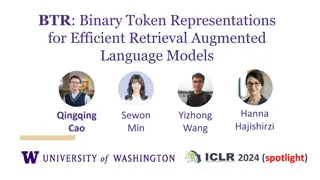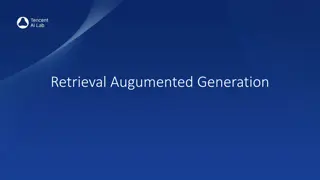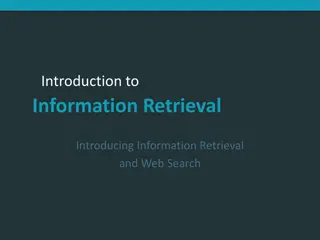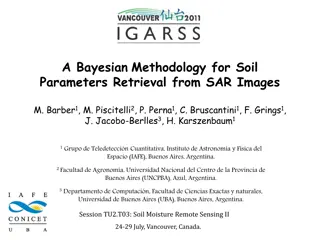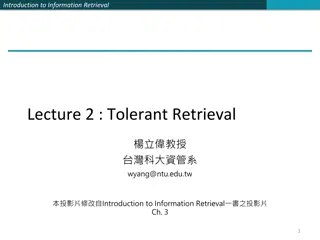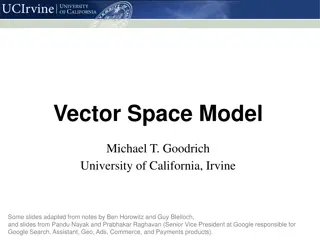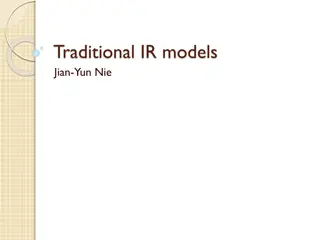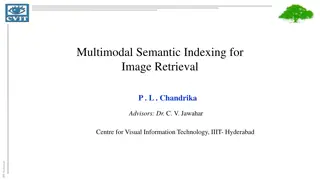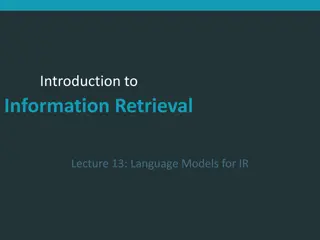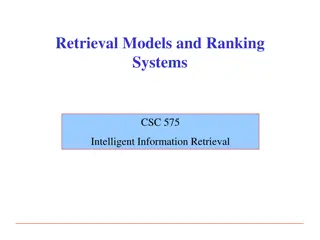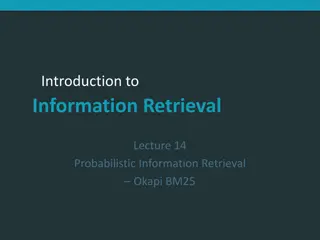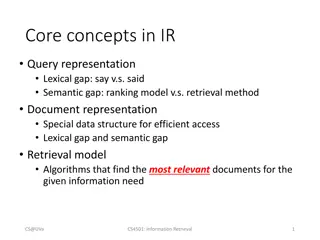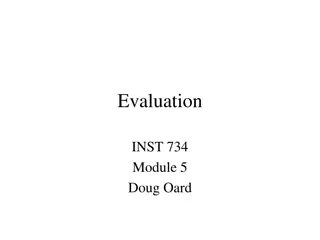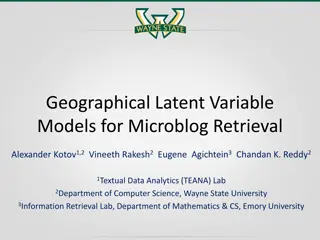Retrieval Models in Information Retrieval
Retrieval models play a crucial role in defining the search process, with various assumptions and ranking algorithms. Relevance, a complex concept, is central to these models, though subject to disagreement. An overview of different retrieval models like Boolean, Vector Space, and Probabilistic Models is provided, emphasizing the importance of relevance in simplifying the search problem. The search process is guided by retrieved documents, with Boolean Retrieval offering predictability but some limitations. The Vector Space Model offers a simple and intuitive representation of documents and queries.
Download Presentation

Please find below an Image/Link to download the presentation.
The content on the website is provided AS IS for your information and personal use only. It may not be sold, licensed, or shared on other websites without obtaining consent from the author.If you encounter any issues during the download, it is possible that the publisher has removed the file from their server.
You are allowed to download the files provided on this website for personal or commercial use, subject to the condition that they are used lawfully. All files are the property of their respective owners.
The content on the website is provided AS IS for your information and personal use only. It may not be sold, licensed, or shared on other websites without obtaining consent from the author.
E N D
Presentation Transcript
Chapter 7 Retrieval Models 1
Retrieval Models Provide a mathematical framework for defining the search process Includes explanation of assumptions Basis of many ranking algorithms Progress in retrieval models has corresponded with improvements in effectiveness Theories about relevance 2
Relevance Complex concept that has been studied for some time Many factors to consider People often disagree when making relevance judgments Retrieval models make various assumptions about relevance to simplify problem e.g.,topical vs. user relevance e.g., binary vs. multi-valued relevance 3
Retrieval Model Overview Older models Boolean retrieval Vector Space model Probabilistic Models BM25 Language models Combining evidence Inference networks Learning to Rank 4
Searching Based on Retrieved Documents Sequence of queries driven by the number of retrieved documents Example. Lincoln search of news articles president AND Lincoln president AND Lincoln AND NOT (automobile OR car) president AND Lincoln AND biography AND life AND birthplace AND gettysburg AND NOT (automobile OR car) president AND Lincoln AND (biography OR life OR birthplace OR gettysburg) AND NOT (automobile OR car) 5
Boolean Retrieval Two possible outcomes for query processing TRUE and FALSE Exact-match retrieval No ranking at all Query usually specified using Boolean operators AND, OR, NOT 6
Boolean Retrieval Advantages Results are predictable, relatively easy to explain Many different document features, such as metadata (e.g., type/date), can be incorporated Efficient processing, since many documents can be eliminated from search Disadvantages Simple queries usually don t work well Complex queries are difficult to construct Effectiveness depends entirely on users 7
Vector Space Model Simple and intuitively appealing Documents and query represented by a vector of term weights Collection represented by a matrix of term weights 8
Vector Space Model Vector Representation of Stemmed Documents w/o Stopwords 9
Vector Space Model 3-D pictures useful, but can be misleading for high- dimensional space 10
Vector Space Model Documents ranked by differences between points representing query and documents Using similarity measure rather than a distance or dissimilarity measure e.g. Cosine correlation 11
Similarity Calculation Consider two documents D1 and D2, and a query Q D1 = (0.5, 0.8, 0.3) Q = (1.5, 1.0, 0) D2 = (0.9, 0.4, 0.2) More similar to Q than D1 12
Term Weights TF-IDF Weight Term frequency weight measures importance in document: Inverse document frequency measures importance in collection: Ensure non-zero weight Some heuristic modifications t t 13
Vector Space Model Advantages Simple computational framework for ranking Any similarity measure or term weighting scheme could be used Disadvantages Assumption of term independence No assumption on whether relevance is binary/multivalued 14
Probabilistic Models According to [Greiff 02] In probabilistic approaches to IR, the occurrence of a query term in a document D contributes to the probability that D will be judged as relevant The weight assigned to a query term should be based on the expected value of that contribution [Greiff 02] Greiff, et al. The Role of Variance in Term Weighting for Probabilistic Information Retrieval. In Proc. of Intl. Conf. on Information and Knowledge Management (CIKM). 2002. 15
IR as Classification Bayes Decision Rule Based on Bayes Classifier (D) Conditional Probability 16
Bayes Classifier Bayes Decision Rule A document D is relevant if P(R | D) > P(NR | D), where P(R | D) and P(NR | D) are conditional probabilities based on the probability of occurrence of words in D that are in R Estimating probabilities Use Bayes Rule A prior probability of relevance Classify a document as relevant if Based on the Bayes Decision Rule P(R | D) > P(NR | D) L.H.S. is the likelihood ratio of D being relevant 17
Estimating P(D | R) Assume word independence (Na ve Bayes assumption) and use individual term/word (di) probabilities Binary (weights in doc) independence (of word) model Document represented by a vector of binary features indicating term occurrence (or non-occurrence) pi is probability that term i occurs in relevant document, si is probability of occurrence of i in non-relevant document Example. Given a document representation (1, 0, 0, 1, 1), the probability of the document occurring in the relevant set is p1 (1 - p2) (1 - p3) p4 p5 18
Binary Independence Model Computing the likelihood ratio of D using pi and si Probability of i in R Probability of i in NR Probability of i not in R Probability of i not in NR word i not in D word i in D 1 (Same for all documents) 19
Binary Independence Model Scoring function is Using log to avoid multiplying lots of small numbers If there is no other information on the relevant set, i.e., neither R nor NR exists, then pi is set to be a constant (= 0.5) si is approximated as ni/ N, where ni is the number of documents in the collection N that include i si is similar to the IDF-like weight 20
Contingency Table, If (non-)Relevant Sets available n where ri = number of relevant documents containing term i ni = number of documents in a collection N containing i R = number of relevant documents in the collection N = number of documents in the collection Gives the scoring function: 21
BM25 Ranking Algorithm A ranking algorithm based on probabilistic arguments and experimental validation, but it is not a formal model Adds document D and query Q term weights fi is the frequency of term i in a document D k1, a constant, plays the role of tf along with fi qfiis the frequency of term i in query Q, much lower than fi k2plays the role as k1 but is applied to query term weight qfi , where dl is document length & avdl is the average length of a doc regulated by b (0 b 1) k1, k2& K are set empirically as 1.2, 0..1000, & 0.75, resp. 22
BM25 Example Given a query with two terms, president lincoln , (qf = 1) No relevance information (ri and R are zero) N = 500,000 documents president occurs in 40,000 documents (n1= 40,000) lincoln occurs in 300 documents (n2 = 300) president occurs 15 times in doc D (f1= 15) lincoln occurs 25 times in doc D (f2= 25) document length is 90% of the average length (dl / avdl = 0.9) k1= 1.2, b = 0.75, and k2= 100 K = 1.2 (0.25 + 0.75 0.9) = 1.11 23
BM25 Example 24
BM25 Example Effect of term frequencies, especially on lincoln The large occurrence of a single important query term can yield a higher score than the occurrence of both query terms 25
Language Model (LM) A language model is associated with each doc & has been successfully applied to search applications to represent the topical content of a document & query LM is a probability distribution over sequences of words to represent docs, i.e., puts a probability measure over strings from some vocabulary, s * P(s) = 1 The original and basic method for using LMs in IR is the query likelihood model in which a document d is constructed from a language model Md, i.e., Estimate a LM for each documentd Rank documents by the likelihood of the query according to the estimated LM, i.e., P(Q | Md) 26
LMs for Retrieval Three possibilities models of topical relevance Probability of generating the query text from a document (language) model, i.e., the query likelihood model tft,d dld Pmle (Q | Md) = t Q Pmle (t | Md), where Pmle (t | Md) = Probability of generating the document text from a query (language) model, i.e., Pmle (D |Mq) = Pmle (D | R), where R is the set of relevant documents of a query q Comparing the language models representing the query and document topics 27
LMs for Retrieval Three ways of developing the LM modeling approach: The Query Likelihood Model: P(Q | Md) or P(Q | D) a) The Document Likelihood Model: P(D | MQ) or P(D | R) b) Comparison of the query and document LMs using KL- Divergence c) 28
LMs for Retrieval The Query Likelihood Model Documents are ranked based on the probability that the queryQ could be generated by the document model (i.e., on the same topic) based on doc D, i.e., P(Q | D) Given a query Q = q1 qn and a document D = d1 dm, compute the conditional probability P(D | Q) A prior probability of document D P(D | Q) = P(Q | D) P(D) (Assumed to be uniform) where P(Q | D) P(D) is the query likelihood given D & P(D) is the prior belief that D is relevant to any query 29
Estimating Probabilities Obvious estimate for unigram probabilities is Maximum likelihood estimate (mle) Makes the observed value of fqi,Dmost likely If any query words are missing from document, score will be zero Missing 1 out of 4 query words same as missing 3 out of 4 30
LMs for Retrieval Example. The Query Likelihood Model Given the two (unigram) LMs, M1 and M2, as shown below Model M1 Model M2 Q: Frog said that toad likes that dog the a frog toad said likes that dog cat monkey 0.2 0.1 0.01 0.01 0.03 0.02 0.04 0.005 0.003 0.001 the a frog toad said likes that dog cat Monkey 0.15 0.12 0.0002 0.0001 0.03 0.04 0.04 0.01 0.015 0.002 M1 0.01 0.03 0.04 0.01 0.02 0.04 0.005 M2 0.0002 0.03 0.04 0.0001 0.04 0.04 0.01 P(Q | M1) = 0.00000000000048 P(Q | M2) = 0.00000000000000034 P(Q | M1) > P(Q | M2) 31
The Language Models Example. Using language models, we estimate if Barbie car (i.e., treated as Q) is generated from content (i.e., treated as M) targeting younger or adults P( | Barbie car ) = P( Barbie car | ) = 0.0056 0.0039 = 0.00002184 Words Probability on Simple Wiki 0.0042 0.0039 0.0056 0.00000001 0.0003 0.0076 Probabilit on Wikipedia Blue Car Barbie Auburn Software Toy 0.0043 0.0048 0.0002 0.0439 0.0756 0.0037 P( | Barbie car ) = P( Barbie car | ) = 0.0048 0.0002 = 0.00000096 Based on the results, it is more likely that Barbie car is generated from content written for younger audiences 32
LMs for Retrieval The Document Likelihood Model Instead of using the probability of a document language model (Md) generating the query, use the probability of a query language model Mq generating the document Creating a document likelihood model, even though it is less appealing, since there is much less text available to estimate a LM based on the query text Solution: incorporate relevance feedback into the model & update the language model Mq e.g., the relevance model of Lavrenko & Croft (2001) is an instance of a document likelihood model that incorporates pseudo relevance feedback into an LM approach 33
Language Model (LM) - Example Consider the query Q= Frozen Movie & the following documents, where R is relevant & NR is non-relevant Frozen Character Anna Disney Movie Elsa Frozen Disney Sven Frozen Food from Fridge R R R NR Words (R) Frozen P(w) 2/9 Character 1/9 Anna 1/9 Disney 2/9 Movie 1/9 Elsa 1/9 Sven 1/9 34
Language Model (LM) - Example Using the following query language model (Mq) we estimate the probability of docs D1 and D2 on their relevance for query Q= Frozen Movie Words (R) P(w) D1: Sven, Anna, Disney, Frozen P(D1 | Mq) = t D1P(t | Mq) = 1/9 1/9 2/9 2/9 = 4/6561 = 0.00061 Frozen 2/9 Character 1/9 Anna 1/9 Disney 2/9 Movie 1/9 Elsa 1/9 D2: Frozen ice cream P(D2 | Mq) = t D2P(t | Mq) = 2/9 0 0 = 0 Sven 1/9 35
LMs for Retrieval Comparing the Query Likelihood Model & Document Likelihood Model Rather than generating either a document language model (Md) or a query language model (Mq), create an LM from both the document & query & find the difference To model the risk of returning a document d as relevant to a query q, use the KL-divergence P(t | Mq) P(t | Md) R(d; q) = KL(Md || Mq) = t VP(t | Mq) log KL-divergence measures how bad the probability distribution Mq is at modeling Md It has been shown that the comparison model outperforms both query-likelihood & document-likelihood models and useful for ad hoc retrieval 36
KL-Divergence Example. Consider the probability distributions generated using texts from Simple Wikipedia (a simplified version of Wikipedia) and Wikipedia Probabilities generated using text targeting younger versus more mature audiences Words Probability based on Simple Wiki 0.0042 0.0039 0.0056 0.00000001 0.0003 0.0076 Probability based on Wikipedia 0.0043 0.0048 0.0002 0.0439 0.0756 0.0037 Blue Car Barbie Auburn Software Toy 37
KL-Divergence Example (Cont.). Using K-L Divergence on vocabulary K-L Divergence ( || ) = (0.0043 log (0.0043/0.0042) + 0.0048 log (0.0048/0.0039) + 0.0002 log (0.002/0.0056) + 0.0439 log (0.0439/0.00000001) + 0.0756 log (0.0756/0.0003) + 0.0037 log (0.0037/0.0076)) = 0.47218 The vocabulary distribution for children versus more mature audiences is indeed different 38
Smoothing Document texts are a sample from the language model Missing words (in a document) should not have zero probability of occurring Smoothing is a technique for estimating probabilities for missing (or unseen) words for the words that are not seen in the text Lower (or discount) the probability estimates for words that are seen in the document text Assign that left-over probability to the estimates 39
Smoothing As stated in [Zhai 04] Smoothing is the problem of adjusting the maximum likelihood estimator to compensate for data sparseness and it is required to avoid assigning zero probability to unseen words Smoothing accuracy is directly related to the retrieval performance: The retrieval performance is generally sensitive to smoothing parameters Smoothing plays two different roles: Making the estimated document LM more accurate Explaining the non-informative words in the query 40
Estimating Probabilities Estimate for unseen words is D P(qi | C) P(qi | C) is the probability for query word i in the collection language model for collection C (background probability) D, which can be a constant, is a coefficient of the probability assigned to unseen words, depending on the document D Estimate for words that occur is (1 D) P(qi | D) + D P(qi | C) Different forms of estimation come from different D 41
Estimating Probabilities Different forms of estimation come from different D (or ) where ps(w | d) is the smoothed probability of a word seen in d, p(w | C) is the collection language model, dis a coefficient controlling the probability mass assigned to unseen words, all probabilities sum to one 42
Jelinek-Mercer Smoothing D is a constant, (= 0.1 for short queries or = 0.7 for long queries in TREC evaluations Gives estimate of Ranking score Use logs for convenience: solve the accuracy problem of multiplying small numbers 43
Where is tf-idf Weight? i: fqi,D> 0 i: fqi,D= 0 i: 1..n Same for all documents TF IDF Proportional to the term frequency (TF), inversely proportional to the collection frequency (IDF) 44
Dirichlet Smoothing D depends on document length where is a parameter value set empirically Gives probability estimation of and document score 45
Query Likelihood Example. Given , Let Q be President Lincoln , D (a doc) in C(ollection) For the term President , let fqi,D= 15, cqi = 160,000 For the term Lincoln , let fqi,D= 25, cqi= 2,400 Let no. of word occurrences in D (i.e., |D|) be 1,800 Let no. of word occurrences in C be 109 = 500,000 (docs) 2,000 (average no. of words in a doc) = 2,000 Negative due to the summating logs of small numbers 46
Set Theoretic Models The Boolean model imposes a binary criterion for deciding relevance The question of how to extend the Boolean model to accomodate partial matching and a ranking has attracted considerable attention in the past Two set theoretic models for this extension are Fuzzy Set Model Extended Boolean Model 48
Fuzzy Queries Binary queries are based on binary logic, in which a document either satisfies or does not satisfy a query. Fuzzy queries are based on fuzzy logic, in which a query term is considered as a fuzzy set & each document is given a degree of relevance with respect to a query, usually [0 1]. Example. In binary logic: The set of "tall people" are defined as those > 6 feet. Thus, a person 5' 9.995" is not considered tall. In fuzzy logic: no clear distinction on tall people. Every person is given a degree of membership to the set of tall people, e.g., a person 7'0" will have a grade 1.0 a person 4'5" will have a grade 0.0 a person 6 2" will have a grade 0.85 a person 5 8" will have a grade 0.7 49
Fuzzy Queries Binary Logic vs. Fuzzy Logic TALL TALL 1 1 0 0 6.5 6.5 4.5 Binary (crisp) Logic Fuzzy Logic 50
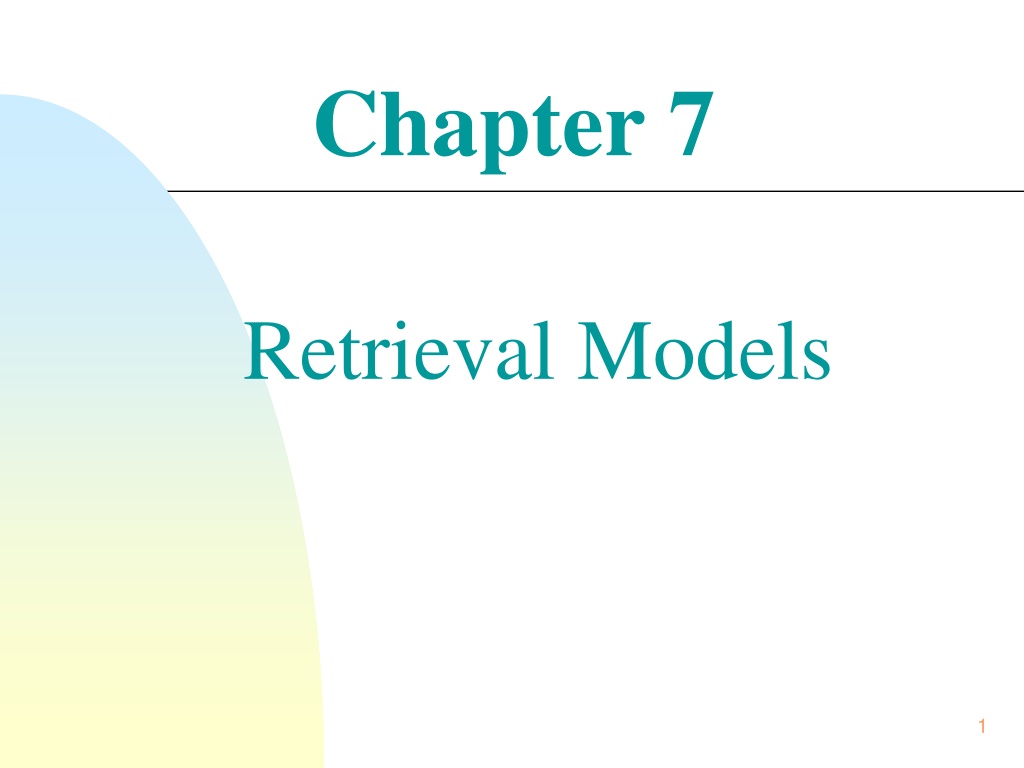
 undefined
undefined




